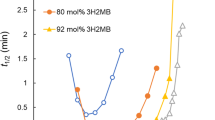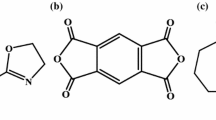Abstract
Poly(3-hydroxybutyrate) (PHB) is a particular biodegradable polyester that is mainly produced by fermentation of bacteria. Besides microbial degradation, it can also be degraded by several other methods including hydrolytic degradation, alcoholysis degradation and thermal degradation. The degraded PHB products can be used in various applications such as chain extender, plasticizer, coating and painting. In this study, a high-molecular-weight PHB was degraded by methanolysis and catalyzed by acid; and the produced PHB oligomer with one terminal hydroxyl group was used to initiate the ring-opening polymerization of lactide to produce poly(3-hydroxybutyrate)-b-poly(lactic acid) (PHB-b-PLA) block copolymer. The alcoholysis kinetics of the PHB was investigated at 80, 90, and 100 °C, and found to obey a pseudo-first-order reaction. The rate constants were in the range of 2.45 to 3.68×10−4 1/min, and the activation energy derived from the Arrhenius plot was 22.3 kJ/mol. Moreover, the molecular weight and glass transition temperature (Tg) of various PHB oligomers after degradation were all measured, and a linear plot of the Tg with the reciprocal of the molecular weight indicated a Tg of 4.3 °C for the PHB with infinite molecular weight. Moreover, unlike the immiscible PLA/PHB blends, the synthesized PHB-b-PLA block copolymer was miscible with the PLA, in which there was only one Tg in each of PLA/PHB-b-PLA blends. The Tg of the blend decreased with increasing the composition of PHB-b-PLA; and the Tg-composition relationship was fitted very well by both Fox’s equation and Gordon-Taylor equation.






Similar content being viewed by others
References
Luckachan GE, Pillai CKS (2011) Biodegradable polymers- a review on recent trends and emerging perspectives. J Polym Environ 19(3):637–676. https://doi.org/10.1007/s10924-011-0317-1
Armentano I, Dottori M, Fortunati E, Mattioli S, Kenny JM (2010) Biodegradable polymer matrix nanocomposites for tissue engineering: a review. Polym Degrad Stab 95(11):2126–2146. https://doi.org/10.1016/j.polymdegradstab.2010.06.007
Amass W, Amass A, Tighe B (1998) A review of biodegradable polymers: uses, current developments in the synthesis and characterization of biodegradable polyesters, blends of biodegradable polymers and recent advances in biodegradation studies. Polym Int 47(2):89–144. https://doi.org/10.1002/(SICI)1097-0126(1998100)47:2<89::AID-PI86>3.0.CO;2-F
Pillai CKS, Paul W, Sharma CP (2009) Chitin and chitosan polymers: chemistry, solubility and fiber formation. Prog Polym Sci 34:641–678. https://doi.org/10.1016/j.progpolymsci.2009.04.001
Auras RA, Lim LT, Selke SEM, Tsuji H (2010) Poly(lactic acid): synthesis, structures, properties, processing, and applications. Wiley, New Jersey
Lenz RW, Marchessault RH (2005) Bacterial polyesters: biosynthesis, biodegradable plastics and biotechnology. Biomacromolecules 6(1):1–8. https://doi.org/10.1021/bm049700c
Sudesh K, Abe H, Doi Y (2000) Synthesis, structure and properties of polyhydroxyalkanoates: biological polyesters. Prog Polym Sci 25:1503–1555. https://doi.org/10.1016/S0079-6700(00)00035-6
Nguyen S, Yu G-e, Marchessault RH (2002) Thermal degradation of poly(3-hydroxyalkanoates): preparation of well-defined oligomers. Biomacromolecules 3:219–224. https://doi.org/10.1021/bm0156274
Plackett D (2012) PHA/clay nano-biocomposites. Eds. Avérous L, Pollet E, Environmental silicate nano-biocomposites. ISBN: 978-1-4471-4101-3, Chapt. 6:143-163, Springer-Verlag, London
Ray SS, Bousmina M (2005) Biodegradable polymers and their layered silicate nanocomposites: in greening the 21st century materials world. Prog Mater Sci 50:962–1079. https://doi.org/10.1016/j.pmatsci.2005.05.002
Bordes P, Pollet E, Avérous L (2009) Nano-biocomposites: biodegradable polyester/nanoclay systems. Prog Polym Sci 34(2):125–155. https://doi.org/10.1016/j.progpolymsci.2008.10.002
Hay JN, Sharma L (2000) Crystallisation of poly(3-hydroxybutyrate)/polyvinyl acetate blends. Polymer 41:5749–5757. https://doi.org/10.1016/S0032-3861(99)00807-1
You J-W, Chiu H-J, Don T.-M (2003) Spherulitic morphology and crystallization kinetics of melt-miscible blends of poly(3-hydroxybutyrate) with low molecular weight poly(ethylene oxide). Polymer 44(15):4355–4362. https://doi.org/10.1016/S0032-3861(03)00348-3
Panaitescu DM, Nicolae CA, Frone AN, Chiulan I, Stanescu PO, Draghici C, Iorga M, Mihailescu M (2017) Plasticized poly(3-hydroxybutyrate) with improved melt processing and balanced properties. J Appl Polym Sci 134:44810. https://doi.org/10.1002/app.44810
Garcia-Garcia D, Ferri JM, Montanes N, Lopez-Martinez J, Balart R (2016) Plasticization effects of epoxidized vegetable oils on mechanical properties of poly(3-hydroxybutyrate). Polym Inter 65(10):1157–1164. https://doi.org/10.1002/pi.5164
Debuissy T, Pollet E, Avérous L (2017) Synthesis and characterization of block poly(ester-ether-urethane)s from bacterial poly(3-hydroxybutyrate) oligomers. J Polym Sci Polym Chem 55(11):1949–1961. https://doi.org/10.1002/pola.28567
Debuissy T, Pollet E, Avérous L (2016) Enzymatic synthesis of a bio-based copolyester from poly(butylene succinate) and poly((r)-3-hydroxybutyrate): study of reaction parameters on the transesterification rate. Biomacromolecules 17(12):4054–4063. https://doi.org/10.1021/acs.biomac.6b01494
Barouti G, Guillaume SM (2016) Polyhydroxybutyrate (PHB)-based triblock copolymers: synthesis of hydrophobic PHB/poly(benzyl β-malolactonate) and amphiphilic PHB/poly(malic acid) analogues by ring-opening polymerization. Polym Chem 7(28):4603–4608. https://doi.org/10.1039/c6py00910g
Li J, Li X, Ni X, Wang X, Li H, Leong KW (2006) Self-assembled supramolecular hydrogels formed by biodegradable PEO–PHB–PEO triblock copolymers and α-cyclodextrin for controlled drug delivery. Biomaterials 27:4132–4140. https://doi.org/10.1016/j.biomaterials.2006.03.025
Reeve MS, McCarthy SP, Gross RA (1993) Preparation and characterization of (R)-poly(β.-hydroxybutyrate)-poly(ε-caprolactone) and (R)-poly(β-hydroxybutyrate)-poly(lactide) degradable diblock copolymers. Macromolecules 26: 888–894. https://doi.org/10.1021/ma00057a002
Andrade AP, Neuenschwander P, Hany R, Egli T, Witholt B, Li Z (2002) Synthesis and characterization of novel copoly(ester−urethane) containing blocks of poly-[(R)-3-hydroxyoctanoate] and poly-[(R)-3-hydroxybutyrate]. Macromolecules 35:4946–4950. https://doi.org/10.1021/ma012223v
Krishnan S, Pandey P, Mohanty S, Nayak SK (2016) Toughening of polylactic acid: an overview of research progress. Polym-Plast Tech Eng 55(15):1623–1652. https://doi.org/10.1080/03602559.2015.1098698
Lai S-M, Wu S-H, Lin G-G, Don T-M (2014) Unusual mechanical properties of melt-blended poly(lactic acid) (PLA)/clay nanocomposites. Eur Polym J 52(1):193–206. https://doi.org/10.1016/j.eurpolymj.2013.12.012
Murariu M, Da Silva FA, Pluta M, Bonnaud L, Alexandre M, Dubois P (2008) Polylactide (PLA)-CaSO4 composites toughened with low molecular weight and polymeric Ester-like plasticizers and related performances. Eur Polym J 44:3842–3852. https://doi.org/10.1016/j.eurpolymj.2008.07.055
Ma P, Hristova-Bogaerds DG, Goossens JGP, Spoelstra AB, Zhang Y, Lemstra PJ (2012) Toughening of poly(lactic acid) by ethylene-co-vinyl acetate copolymer with different vinyl acetate contents. Eur Polym J 48:146–154. https://doi.org/10.1016/j.eurpolymj.2011.10.015
Oyama HT (2009) Super-tough poly(lactic acid) materials: reactive blending with ethylene copolymer. Polymer 50(3):747–751. https://doi.org/10.1016/j.polymer.2008.12.025
Hao Y, Liang H, Bian J, Sun S, Zhang H, Dong L (2014) Toughening of polylactide with epoxy-functionalized methyl methacrylate-butadiene copolymer. Polym Int 63:660–666. https://doi.org/10.1002/pi.4561
Zhang L, Xiong C, Deng X (1996) Miscibility, crystallization and morphology of poly(ß-hydroxybutyrate)/poly(D,L-lactide) blends. Polymer 37(2):235–241. https://doi.org/10.1016/0032-3861(96)81093-7
Zhang M, Thomas NL (2011) Blending polylactic acid with polyhydroxybutyrate: the effect on thermal, mechanical, and biodegradation properties. Adv Polym Technol 30(2):67–79. https://doi.org/10.1002/adv.20235
Furukawa T, Sato H, Murakami R, Zhang J, Duan YX, Noda I, Ochiai S, Ozaki Y (2005) Structure, dispersibility, and crystallinity of poly(hydroxybutyrate)/Poly(L-lactic acid) blends studied by FT-IR microspectroscopy and differential scanning calorimetry. Macromolecules 38:6445–6454. https://doi.org/10.1021/ma0504668
Park JW, Doi Y, Iwata T (2004) Uniaxial drawing and mechanical properties of poly[(R)-3-hydroxybutyrate]/poly(L-lactic acid) blends. Biomacromolecules 5:1557–1566. https://doi.org/10.1021/bm049905l
Koyama N, Doi Y (1997) Miscibility of binary blends of poly[(R)-3-hydroxybutyric acid] and poly[(S)-lactic acid]. Polymer 38(7):1589–1593. https://doi.org/10.1016/S0032-3861(96)00685-4
Zhang J, Sato H, Furukawa T, Tsuji H, Noda I, Ozaki Y (2006) Crystallization behaviors of poly(3-hydroxybutyrate) and poly(L-lactic acid) in their immiscible and miscible blends. J Phys Chem B 110:24463–24471. https://doi.org/10.1021/jp065233c
Ohkoshi I, Abe H, Doi Y (2000) Miscibility and solid-state structures for blends of poly[(S)-lactide] with atactic poly[(R,S)-3-hydroxybutyrate]. Polymer 41(15):5985–5992. https://doi.org/10.1016/S0032-3861(99)00781-8
Lai S-M, Liu Y-H, Huang C-T, Don T-M (2017) Miscibility and toughness improvement of poly(lactic acid)/poly(3-Hydroxybutyrate) blends using a melt-induced degradation approach. J Polym Res 24:102. https://doi.org/10.1007/s10965-017-1253-0
Sun J, Dai ZW, Chen GQ (2007) In vitro effect of oligo-hydroxyalkanoates on the growth of mouse fibroblast cell line L929. Biomaterials 28:3896–3903. https://doi.org/10.1016/j.biomaterials.2007.05.011
Wu L, Chen S, Li Z, Xu K, Chen G-Q (2008) Synthesis, characterization and biocompatibility of novel biodegradable poly[((R)-3-hydroxybutyrate)-block-(D,L-lactide)-block-(ε-caprolactone)] triblock copolymers. Polym Int 57:939–949. https://doi.org/10.1002/pi.2431
Li S, McCarthy S (1999) Influence of crystallinity and stereochemistry on the enzymatic degradation of poly(lactide)s. Macromolecules 32:4454–4456. https://doi.org/10.1021/ma990117b
Polyák P, Szemerszki D, Vörös G, Pukánszky B (2017) Mechanism and kinetics of the hydrolytic degradation of amorphous poly(3-hydroxybutyrate). Polym Degrad Stab 140:1–8. https://doi.org/10.1016/j.polymdegradstab.2017.03.021
Špitalský Z, Lacík I, Lathová E, Janigová I, Chodák I (2006) Controlled degradation of polyhydroxybutyrate via alcoholysis with ethylene glycol or glycerol. Polym Degrad Stab 91:856–861. https://doi.org/10.1016/j.polymdegradstab.2005.06.019
Majid MIA, Ismail J, Few LL, Tan CF (2002) The degradation kinetics of poly(3-hydroxybutyrate) under non-aqueous and aqueous conditions. Eur Polym J 38(4):837–839. https://doi.org/10.1016/S0014-3057(01)00226-9
Lehrle R, Williams R, French C, Hammond T (1995) Thermolysis and methanolysis of poly(β-hydroxybutyrate): random scission assessed by statistical analysis of molecular weight distributions. Macromolecules 28:4408–4414. https://doi.org/10.1021/ma00117a008
Song X, Wang H, Liu F, Yu S (2016) Kinetics and mechanism of monomeric product from methanolysis of poly (3-hydroxybutyrate) catalyzed by acidic functionalized ionic liquids. Polym Degrad Stab 130:22–29. https://doi.org/10.1016/j.polymdegradstab.2016.05.023
Jakić M, Stipanelov Vrandečić N, Erceg M (2016) Thermal degradation of poly(3-hydroxybutyrate)/poly(ethylene oxide) blends: thermogravimetric and kinetic analysis. Eur Polym J 81:376–385. https://doi.org/10.1016/j.eurpolymj.2016.06.024
Rajaratanam DD, Ariffin H, Hassan MA, Nishida H (2016) Changes in diad sequence distribution by preferential chain scission during the thermal hydrolysis of poly(3-hydroxybutyrate-co-3-hydroxyhexanoate). Polym J 48(7):839–842. https://doi.org/10.1038/pj.2016.28
Michalak M, Kwiecień M, Kawalec M, Kurcok P (2016) Oxidative degradation of poly(3-hydroxybutyrate). A new method of synthesis for the malic acid copolymers. RSC Adv 6(16):12809–12818. https://doi.org/10.1039/C5RA27041C
Flory PJ (1940) Kinetics of the degradation of polyesters by alcohols. J Am Chem Soc 62:2255–2261
Halacheva N, Novakov P (1995) Preparation of oligoester diols by alcoholytic destruction of poly(ethylene terephthalate). Polymer 36(4):867–874. https://doi.org/10.1016/0032-3861(95)93119-7
Acknowledgements
The authors wish to thank the Ministry of Science and Technology (MOST) in Taiwan for the financial support under the contract number MOST 101-2221-E-032-002-MY3.
Author information
Authors and Affiliations
Corresponding author
Rights and permissions
About this article
Cite this article
Don, TM., Liao, KH. Studies on the alcoholysis of poly(3-hydroxybutyrate) and the synthesis of PHB-b-PLA block copolymer for the preparation of PLA/PHB-b-PLA blends. J Polym Res 25, 38 (2018). https://doi.org/10.1007/s10965-017-1432-z
Received:
Accepted:
Published:
DOI: https://doi.org/10.1007/s10965-017-1432-z




